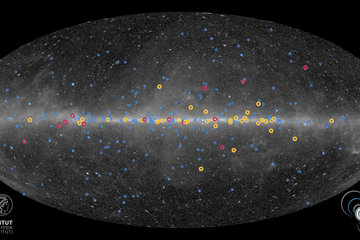Pulsating gamma rays from neutron star rotating 707 times a second
Second fastest spinning radio pulsar known is a gamma-ray pulsar, too. Multi-messenger observations look closely at the system and raise new questions.
An international research team led by the Max Planck Institute for Gravitational Physics (Albert Einstein Institute; AEI) in Hannover has discovered that the radio pulsar J0952-0607 also emits pulsed gamma radiation. J0952-0607 spins 707 times in one second and is 2nd in the list of rapidly rotating neutron stars. By analyzing about 8.5 years worth of data from NASA’s Fermi Gamma-ray Space Telescope, LOFAR radio observations from the past two years, observations from two large optical telescopes, and gravitational-wave data from the LIGO detectors, the team used a multi-messenger approach to study the binary system of the pulsar and its lightweight companion in detail. Their study published in the Astrophysical Journal shows that extreme pulsar systems are hiding in the Fermi catalogues and published in the Astrophysical Journal today shows that extreme pulsar systems are hiding in the Fermi catalogues and motivates further searches. Despite being very extensive, the analysis also raises new unanswered questions about this system.
Neutron stars are compact remnants from supernova explosions and consist of exotic, extremely dense matter. They measure about 20 kilometers across and weigh more than our Sun. Because of their strong magnetic fields and fast rotation they emit beamed radio waves and energetic gamma rays similar to a cosmic lighthouse. If these beams point towards Earth during the neutron star's rotation, it becomes visible as a pulsating radio or gamma-ray source – a so-called pulsar.
Millisecond pulsars form when a pulsar is spun up by accreting matter from a companion star. The inflow of material from the partner star can accelerate the pulsar up to hundreds of rotations in a single second. Once the accretion ends, the rapidly rotating neutron star can be observed as a millisecond pulsar.











